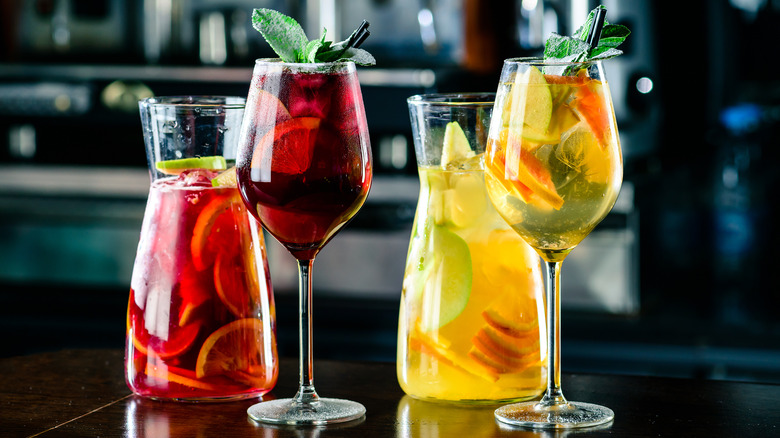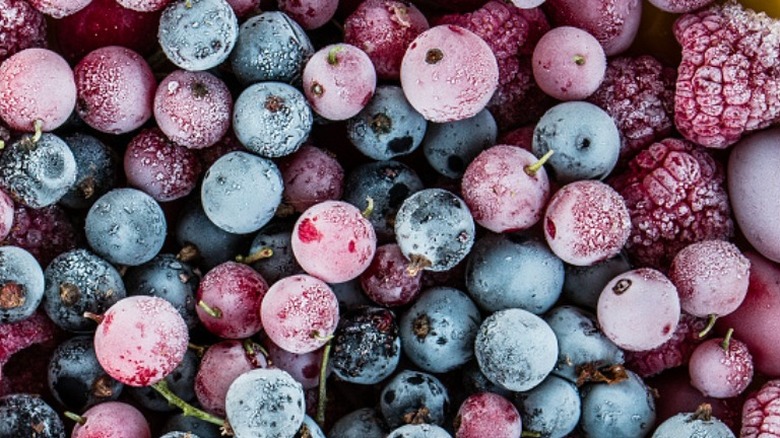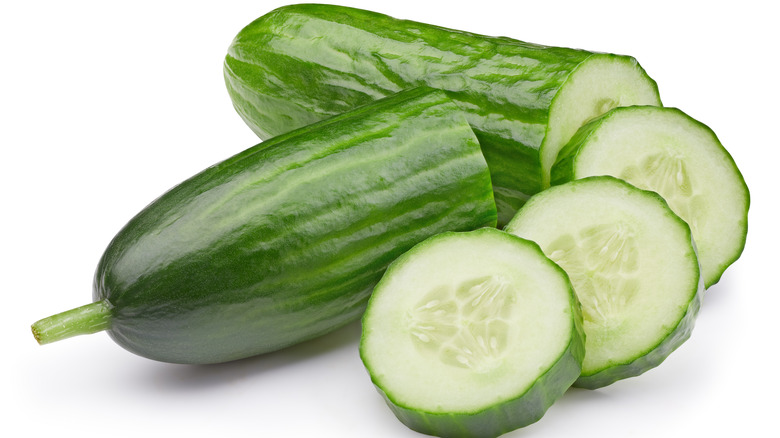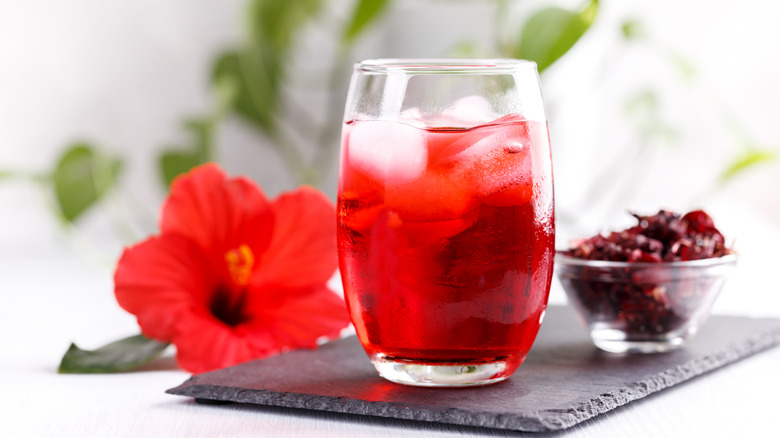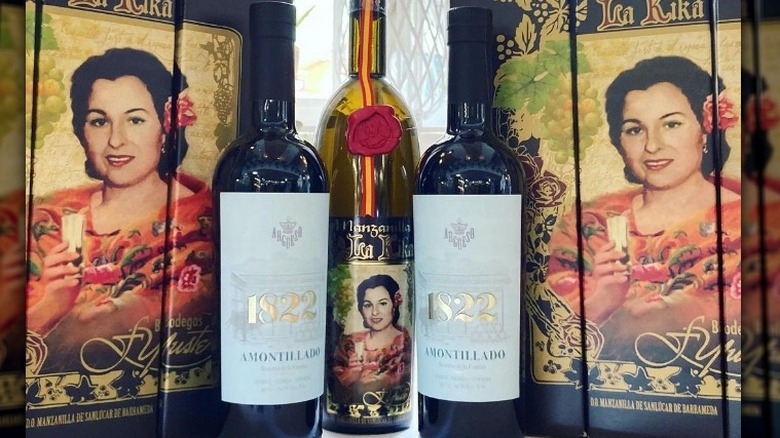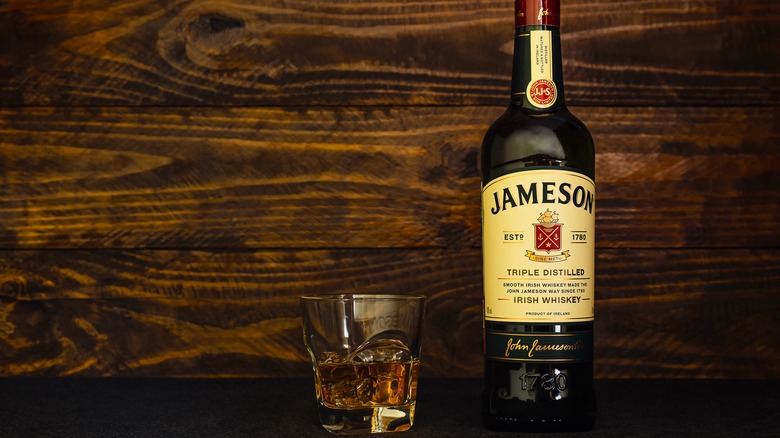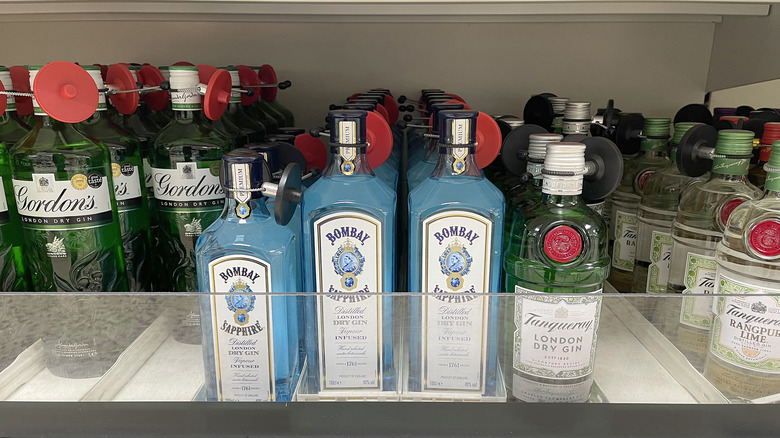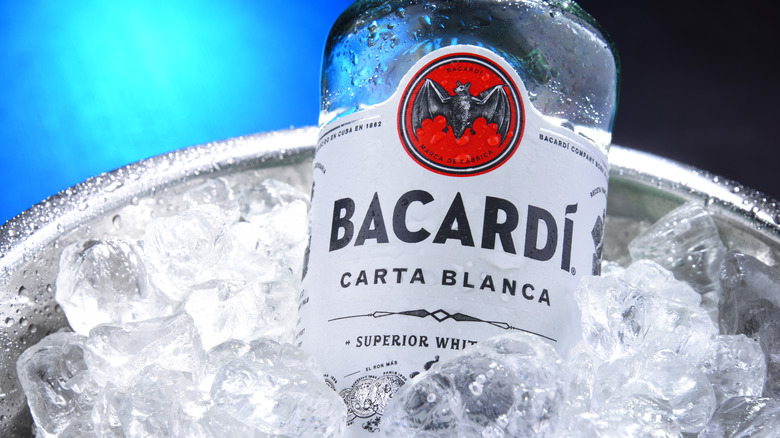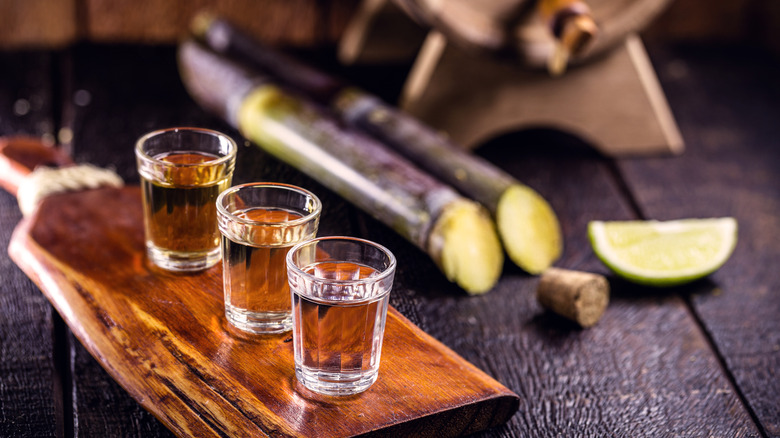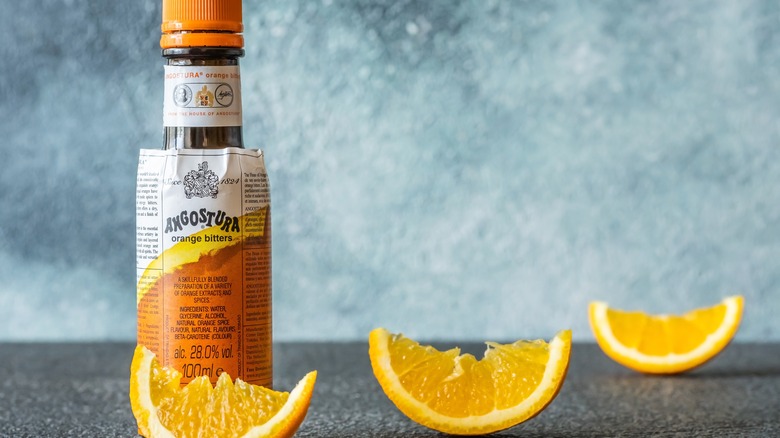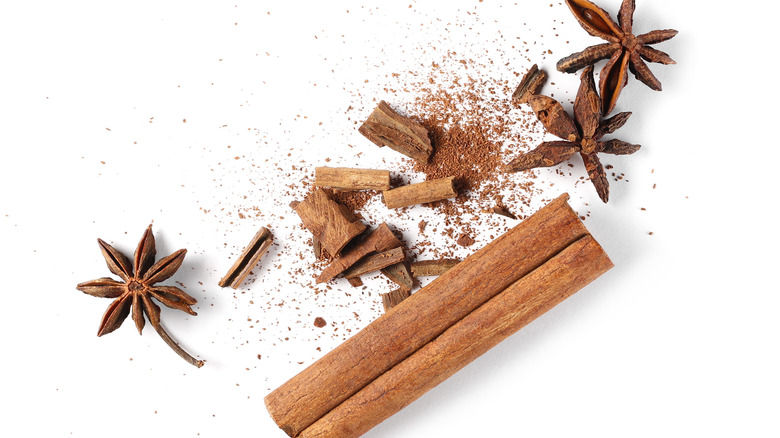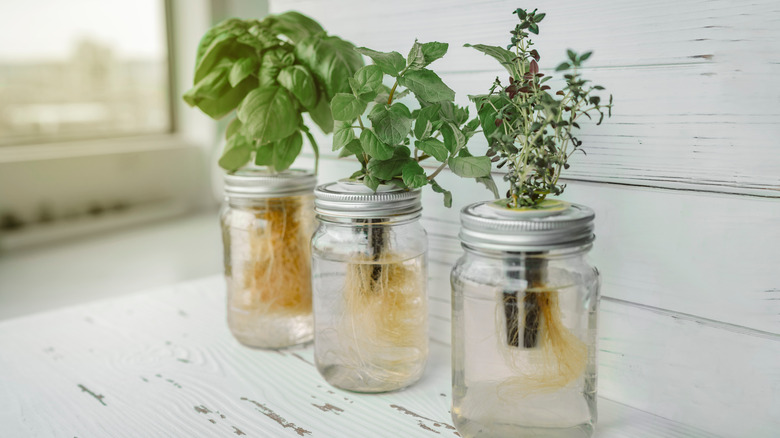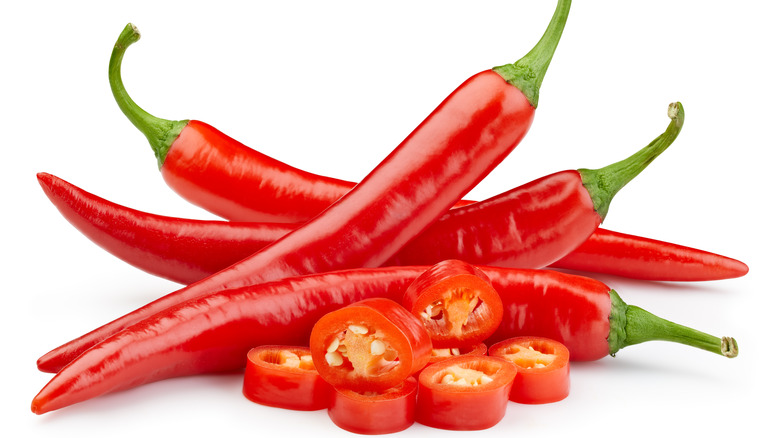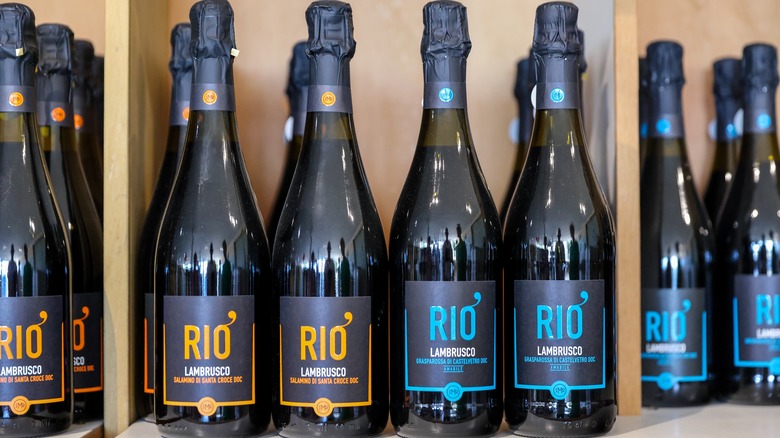13 Ways To Upgrade Your Next Batch Of Sangria
Sangria can be traced back to Ancient Rome when it had a health aspect: Water in Ancient Rome could be full of pathogens, and the wine in sangria helped provide a safer hydration source, or so the story goes. More likely, Ancient Romans liked getting drunk and told themselves that two glasses of sangria a day was good for them, actually. Regardless, sangria was mostly a European drink until the 1964 World's Fair in New York City, where a Spanish vendor made the drink a major American hit.
For decades, we Americans have mostly seen sangria as a way to make cheap red wine more palatable, with wine, fruit, and brandy. But more recently, bartenders have been upgrading the classic drink with all kinds of additions and substitutions. One of the most popular ways to update sangria is to use white wine instead of the traditional red. However, many more interesting ways exist to give this wine cocktail a modern and/or upscale spin.
Keep it chill with frozen fruit
After wine, fruit is the most important ingredient in any sangria, and while the drink can be pretty forgiving, there are some fruits you just shouldn't use in sangria. Bananas and papayas are two popular fruits that go great in smoothies but don't bring anything to sangria. These fruits only become mushy and weird, giving the cocktail some strange textures.
Another big mistake people make is serving sangria warm. Be sure your sangria chills in the refrigerator for at least a couple of hours before enjoying it or serving it to guests. Once you put it out, though, sangria will start to warm up, especially on a hot summer day. While you could put ice cubes in your sangria to keep it cool, ice will water down your drink if it's allowed to melt. A smarter solution is to freeze chunks of sangria-friendly fruit and use these in place of ice cubes. This technique helps to keep your sangria cool while adding flavor, not subtracting it.
Skip the sugar with cucumber
A lot of sangria recipes include added sugar in the form of sugary juices, simple syrup, sugary soda, or sweet liqueurs. While some people like their sangria to be sweet, others find even the most bare-bones sangria recipe to be too sweet.
If you're not a big fan of sugar or watching your sugar intake, using cucumber as a main ingredient is a great way to create a refreshing sangria that doesn't rely on sugar for flavor. Cucumber transformed sangria into more of a savory drink, which you can lean into further with the addition of herbs like mint or basil. Also, cucumbers contain about 95% water. So including the hydrating vegetable in your sangria can help increase the amount of water you're consuming, slightly offsetting the diuretic effects of alcohol. Cucumbers are also full of antioxidants, vitamins, and essential minerals. So on your next Sunday funday, consider having cucumber sangria at brunch, and avoid all the potent sugary drinks that will have you feeling like trash on Monday morning.
Bring floral notes with hibiscus
Brought over from Jamaica by Spanish conquistadors during colonial times, hibiscus is a popular culinary ingredient in modern-day Mexico. The flower is known as "Jamaica" in Mexico and one of the most popular drinks in the country is tangy hibiscus water — or "agua de Jamaica". Interestingly, hibiscus is also used in Mexico as the main ingredient in vegan tacos called "tacos de Jamaica". This use of hibiscus shows off just how savory this flower can actually be.
The flavors of this hibiscus flower are quite similar to those of red wine. In addition to having flavors that recall tart berries and red fruits, hibiscus also has the same slightly astringent quality as many tannic wines. Given that combination of flavors, hibiscus is clearly a natural fit for red wine sangria. Adding hibiscus gives sangria complex floral notes and additional tang on the palate. Also, having red flowers floating in your sangria just looks cool, and it's perfect for the 'gram.
Add complexity with sherry
Let's be honest: Sangria has a bit of a reputation. For years, it's been seen as a way to dress up cheap red wine with all kinds of sugary ingredients. Basically, it's a wine for people who don't like wine. But lately, like a lot of things, sangria is getting a second look from modern bartenders who see the standard formula as highly malleable. Many bartenders are making complex, upscale sangria with the addition of fortified wines like sherry.
Used as a replacement for brandy, the sherry you add can depend on personal taste. However, light and dry amontillado sherry offers a great counterpoint to any sweet, syrupy fruit you might also be adding. If you're looking to get your mixology on, add spent citrus hulls and allow your sangria to rest for several hours in your refrigerator. The tangy notes from the zest and bitter notes from the pith will make your sangria complex, alive, and cocktail-like.
Amp up the flavor with whiskey
Made by floating red wine over a standard whiskey sour, the New York Sour is having a moment right now. The New York Sour is also Exhibit A for why you should consider putting whiskey in your next batch of sangria. Whiskey brings both a high alcohol content and a unique flavor profile to sangria, and it can be easily substituted for brandy as a one-for-one replacement because the two spirits have quite similar qualities. Both whiskey and brandy bring bold deep flavors to any drink, making it more intense. They also provide a solid flavor backbone that you can play off with additional ingredients.
If you are going to add whiskey to your sangria and want to use the New York Sour as a point of reference, then you'll want to make your sangria with a fruity red wine like merlot or shiraz. The deep fruity notes of these wines stand up well it the potent kick of a good whiskey.
Add a botanical punch with gin
Having a mix of pungent botanicals, gin may not seem like a natural fit for sangria, but it can be — if you build the rest of the drink around it. Because gin is going to define the flavor profile of your sangria, it's best to use a neutral wine like dry rosé. One of the best parts about using gin in a rosé sangria is that it adds a ton of flavor without changing the color of the wine. The result is a dry and complex wine cocktail with a pretty pink color. Gin also plays well with citrus fruits like orange, lemon, and lime — making these essential additions to your gin-based rosé sangria.
The other thing to consider when using gin in sangria is which popular gin brand you should use. Each brand of gin has a signature mix of botanicals, so different gin brands will give your sangria a different flavor profile. If you prefer a mild gin taste in your sangria, go with a mild gin like Bombay Sapphire. If you like more juniper flavor but don't want it to overpower your sangria, Aviation is the gin to pick.
Take sangria to the tropics with rum
Sangria and rum might seem like odd bedfellows, but not when you consider the iconic Hurricane cocktail. The Hurricane combines two types of rum with a blend of fruit juices to create a cocktail with a strong fruit punch profile that can resemble a juicy sangria.
Aged or white rum can give your sangria more of a tropical vibe that's perfect for summer. Use a smooth white rum like Bacardi Silver if you want a rum flavor that lilts in the background. If you are a rum fan who likes strong vanilla and caramel flavors, an aged rum can add those flavors, giving your sangria more of a tiki cocktail vibe. Red wine will go well with either type of rum, but you should only combine white wine with white rum. The addition of citrus fruits can help to cement the connection between rum and wine, making it a more harmonious batch of sangria.
Cachaça adds Brazilian flavor
The Brazilian spirit known as cachaça was so unknown to Americans that the first American importers to bring it to the United States mislabeled it as a type of rum. While both spirits are made from sugar cane, cachaça is made from freshly pressed cane juice and rum tends to be made from molasses. Furthermore, cachaça is rested in native Brazilian wood, while rum is often aged in oak barrels that are used to hold sherry or bourbon. When using clear sugar cane-based spirits like rum and cachaça, it's best to lean into the fruity nature of sangria and incorporate tropical fruits like mango, passionfruit, and pineapple. These bright and tangy fruits play well with the grassy notes of cachaça, giving your sangria more of a tropical vibe.
While you could simply use cachaça as your base liquor in sangria, one recipe that's done the rounds on the internet takes a very different approach. This "Brazilian sangria" uses red wine as a float instead of making it the main ingredient. It also incorporates a splash of absinthe, to give the cocktail a bit of red licorice flavor.
Cocktail bitters aren't just for spirit cocktails
Often called the cocktail world's salt-and-pepper, bitters are used to bring out the flavors of a cocktail's other components. For example, in a classic Old Fashioned cocktail, the bitter and medicinal qualities of Angostura bitters bring out earthy complexity from the base spirit, whether that's bourbon or rye whiskey. Unless the ingredients you're already adding to a cocktail already bring a lot of bitterness, you really can't go wrong with adding bitters to a cocktail.
Where you could go wrong is adding the wrong kind of bitters to your cocktail. For sangria, you could play it safe by sticking with Angostura bitters. These all-purpose bitters can bring out the spiciness in red wine or the earthy complexity in brandy. Angostura bitters can also bring out low-key savory notes in the fruit you're using. Yes, there's a savoriness to strawberries and stone fruit hiding behind all that sugar. Other options include Peychaud's bitters for a red wine sangria and orange bitters for a white wine sangria.
Make sangria for winter with baking spices
A Swedish mulled wine called glogg is typically made with red wine, citrus pills, raisins, almonds, and baking spices like cinnamon, anise, and allspice. In an exclusive interview with us, Swedish celebrity chef Marcus Samuelsson talked about his love of glogg and how it's used as an icebreaker at parties. Does any of this sound familiar?
The addition of baking spices to sangria is a natural fit that recalls mulled wine like glogg. If you're going to take your sangria down this road, start by choosing a juicy red wine with a bit of spice. Zinfandel, shiraz, Tempranillo, and Grenache are all good choices. Just don't bother breaking the bank on an expensive bottle because the spices and fruits you add will cover up any complex flavors from the wine. While you don't want to go all the way down the road of mulled wine, this type of sangria tastes better when it isn't served cold. Split the difference by serving your baking spice sangria at room temperature.
Savory herbs give sangria a whole new spin
When people think of savory alcoholic drinks, their mind typically goes to one thing: the Bloody Mary. But actually, there is an entire world of savory cocktails. These are generally considered drinks that don't feature sweetness as a defining taste. Rather than sugar, savory cocktails are defined by flavors that are vegetal, herbal, spice-forward, or umami-rich.
Sangria is often defined by sweetness, but there are also popular versions that put sugar on the back burner. Because sangria is based on deeply flavorful wine, it's easy to take this wine cocktail in more of a savory direction. An easy way to do that is with the addition of savory herbs like basil, thyme, or rosemary. If you are going this route, it helps to think more like a chef and less like a mixologist. In the kitchen, herbs like thyme and basil are often paired with citrus flavors, like those found in citrusy white wines, making these herbs ideal for a savory white sangria.
Add chilies for those who like it hot
Peaches and similar stone fruit are considered a go-to when making sangria, but peaches are also commonly paired with habanero peppers to make a popular hot sauce flavor. If you're doing the math, you should realize that habanero peppers, and chilies in general, should therefore make a great addition to sangria. In fact, chilies offer an ideal counterpoint in a sweeter sangria.
The key to using chilies in sangria is not to let them overpower the drink. Just a little bit of heat can enhance the other flavors and elevate your sangria without scorching the palette. In our peach jalapeño sangria recipe, we use a sachet of muddled peach and sliced jalapeños to add heat to sangria in a controlled manner. The recipe calls for steeping the sachet to taste. If you like a bit of background spice, only steep for 10 minutes. If you want sangria that's on the spicy side, steep the sachet for longer.
Carbonation can lighten up a heavy sangria
Because it's based on a bold-flavored wine and the addition of rich, juicy fruits, sangria can easily slip into being a heavy-feeling drink. Adding carbonation is a great way to counteract the innate heaviness of sangria, and there are a number of ways you can add it. Adding soda water is a straightforward approach and doing so helps to make sangria more session-able.
If you want to add carbonation without watering down the sangria, you could base your sangria on Lambrusco, which is a sparkling red wine. Medici Ermete Lambrusco Concerto is one of the best wines for sangria because it brings strong berry notes in addition to carbonation. A bit of port wine or dark rum can further deepen the flavor of a sangria made with this wine. Bolet Organic Cava Brut Nature Reserva is a sparkling white wine and another great choice for sangria. Combining this wine with mango or guava juice will give you a distinctly tropical sangria while adding peaches or nectarines will keep things closer to traditional white sangria.
Static Media owns and operates Tasting Table and Mashed.
